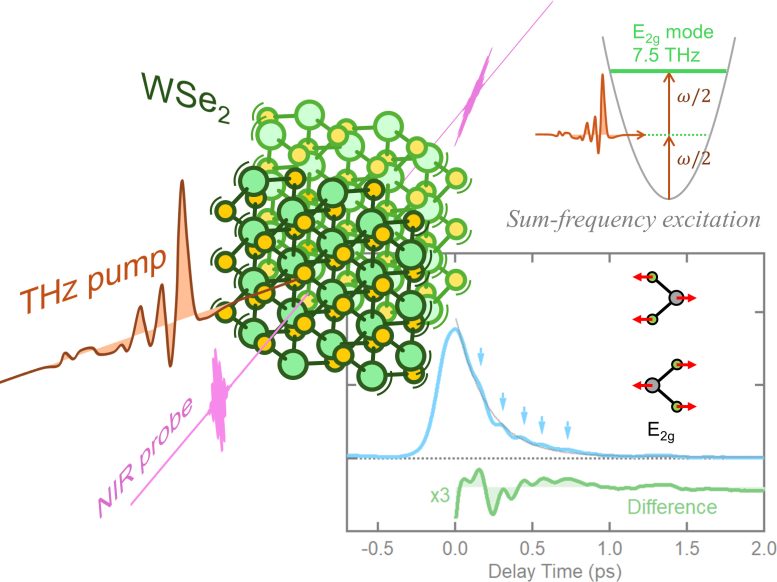
Scientists have developed a new technique using ultrafast terahertz pulses to control atomic motion in two-dimensional semiconductors, promising advancements in high-speed computing and electronic device development.
New study applies ultrafast terahertz frequency radiation to transition metal dichalcogenides, generating coherent phonons.
Semiconductors are a cornerstone of next-generation technology, so a new method to excite atoms in semiconductor materials is likely to excite a broad range of researchers and industries as well.
By leveraging intense and broad-band ultrafast terahertz pulses, scientists from Yokohama National University and their colleagues at the California Institute of Technology have demonstrated atomic excitation in a two-dimensional semiconductor material, advancing the development of electronic devices.
Their paper was published on March 19 and appears as an Editor’s Pick in the journal Applied Physics Letters.
Two-dimensional (2D) materials, or sheet-like nanomaterials, are promising platforms for future semiconductor applications due to their unique electronic properties. Transition metal dichalcogenides (TMDs), a prominent group of 2D materials, consist of layers of transition metal atoms sandwiched between layers of chalcogen atoms. Arranged in a lattice structure, these atoms can vibrate or oscillate around their equilibrium positions — this collective excitation is known as a coherent phonon and plays a crucial role in determining and controlling material properties.
Innovations in Phonon Induction Techniques
Traditionally, coherent phonons are induced by ultrashort pulsed lasers in the visible and near-infrared regions. Methods using other light sources remain limited.
“Our study addresses the fundamental question of how coherent phonons are induced by ultrafast terahertz frequency lasers — or low-energy photons — in TMD materials,” said Satoshi Kusaba, an assistant professor at the Graduate School of Engineering Science of Yokohama National University and first author of the study.

Schematics of the ultrafast broadband terahertz excitation and polarization rotation detection of phonon in WSe2. Obtained result (lower right) includes the coherent phonon oscillation signal excited via sum-frequency process (upper right). Credit: Satoshi Kusaba / Yokohama National University
Terahertz radiation refers to electromagnetic waves with frequencies in the terahertz range, between microwave and infrared frequencies. The research team prepared ultrafast broadband terahertz pulses to induce coherent phonon dynamics in thin films of a TMD called WSe2. A precise and sensitive setup was arranged for detecting optical anisotropy, in other words, how light behaves when it passes through the material. The researchers investigated the changes in the orientation of the electric field of ultrashort laser pulses as they interact with the material; these changes are known as polarization rotation.
By carefully observing the small induced optical anisotropy, the team succeeded in detecting the phonon signals induced by the terahertz pulses.
“The most important finding from our study is that terahertz excitation can induce coherent phonons in TMDs through a distinct sum-frequency excitation process,” said Haw-Wei Lin, a PhD candidate at the California Institute of Technology at the time of research and co-first author of this study. “This mechanism, which is fundamentally different from resonant and linear absorption processes, involves the combined energy of two terahertz photons matching that of the phonon mode.”
Since the symmetry of the phonon modes that can be excited via this sum-frequency process is completely different from that of the more typical resonant linear process, the excitation process successfully used in this study is important for fully controlling atomic motions in materials. The implications of the study’s findings extend beyond fundamental research, holding promise for a variety of real-world applications.
“With the sum frequency excitation process, we can coherently control two-dimensional atomic positions using terahertz excitation,” Kusaba said. “This could open the door for controlling the electronic states of TMDs, which is promising for the development of valleytronics and electronic devices using TMDs for low power-consumption, high-speed computing, and specialized light sources.”
Reference: “Terahertz sum-frequency excitation of coherent optical phonons in the two-dimensional semiconductor WSe2” by Satoshi Kusaba, Haw-Wei Lin, Ryo Tamaki, Ikufumi Katayama, Jun Takeda and Geoffrey A. Blake, 19 March 2024, Applied Physics Letters.
DOI: 10.1063/5.0191558
The study was funded by the Ministry of Education of Taiwan, the National Science Foundation, NASA, and the Japan Society for the Promotion of Science.
Other contributors include Ryo Tamaki, Ikufumi Katayama and Jun Takada from Yokohama National University; Geoffrey A. Blake from California Institute of Technology.









Be the first to comment on "Scientists Discover New Semiconductor Excitation Technique"